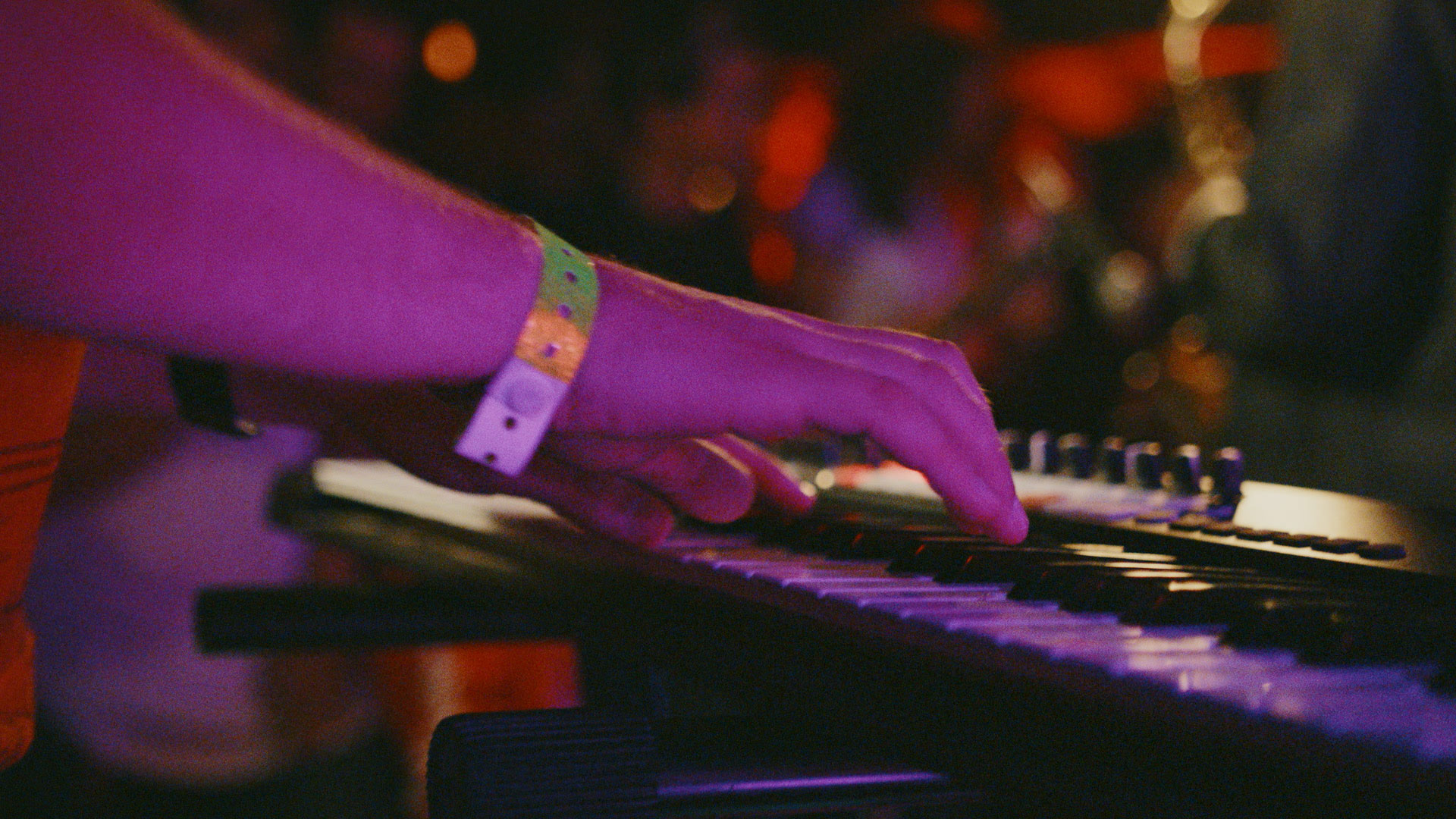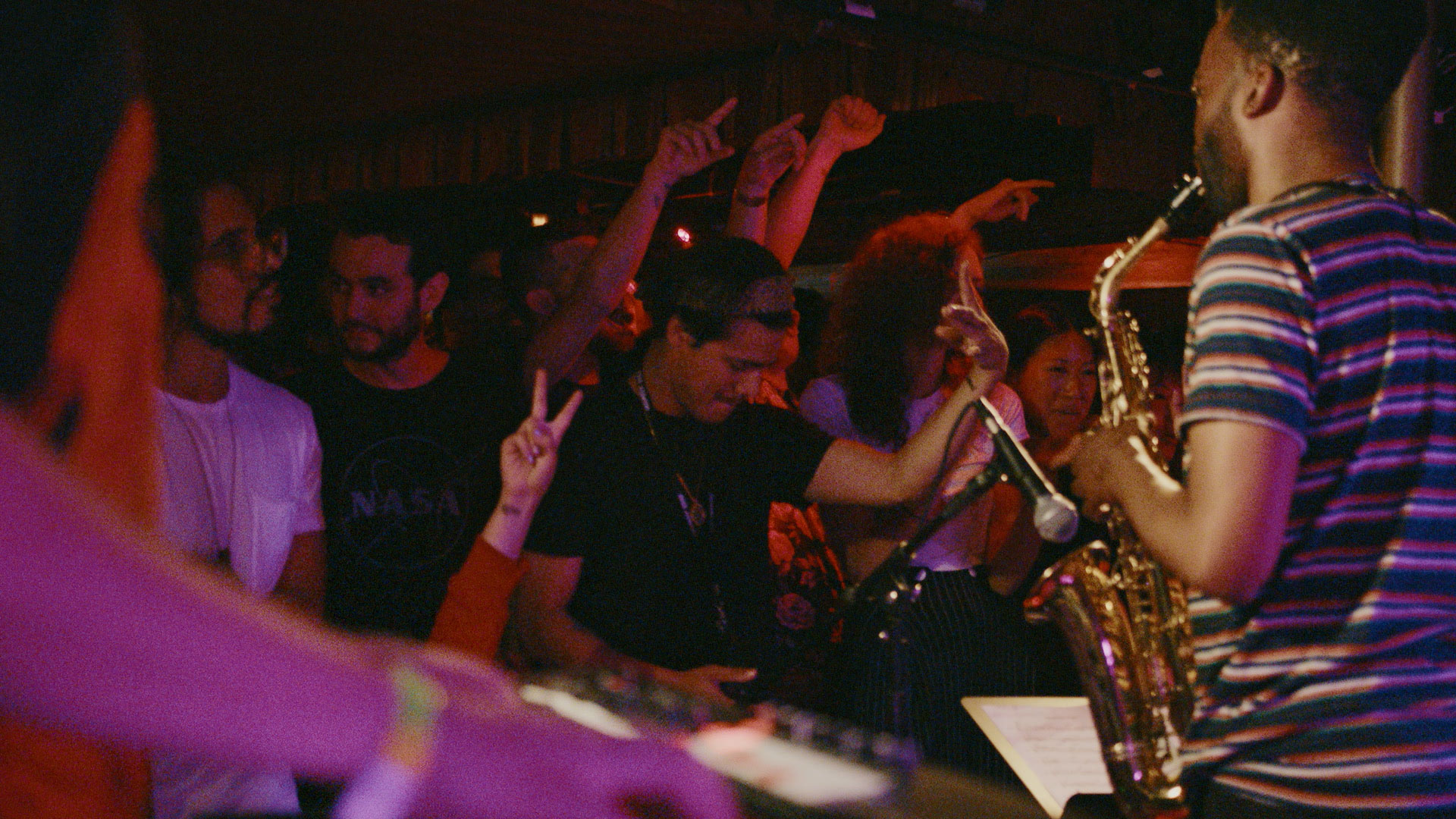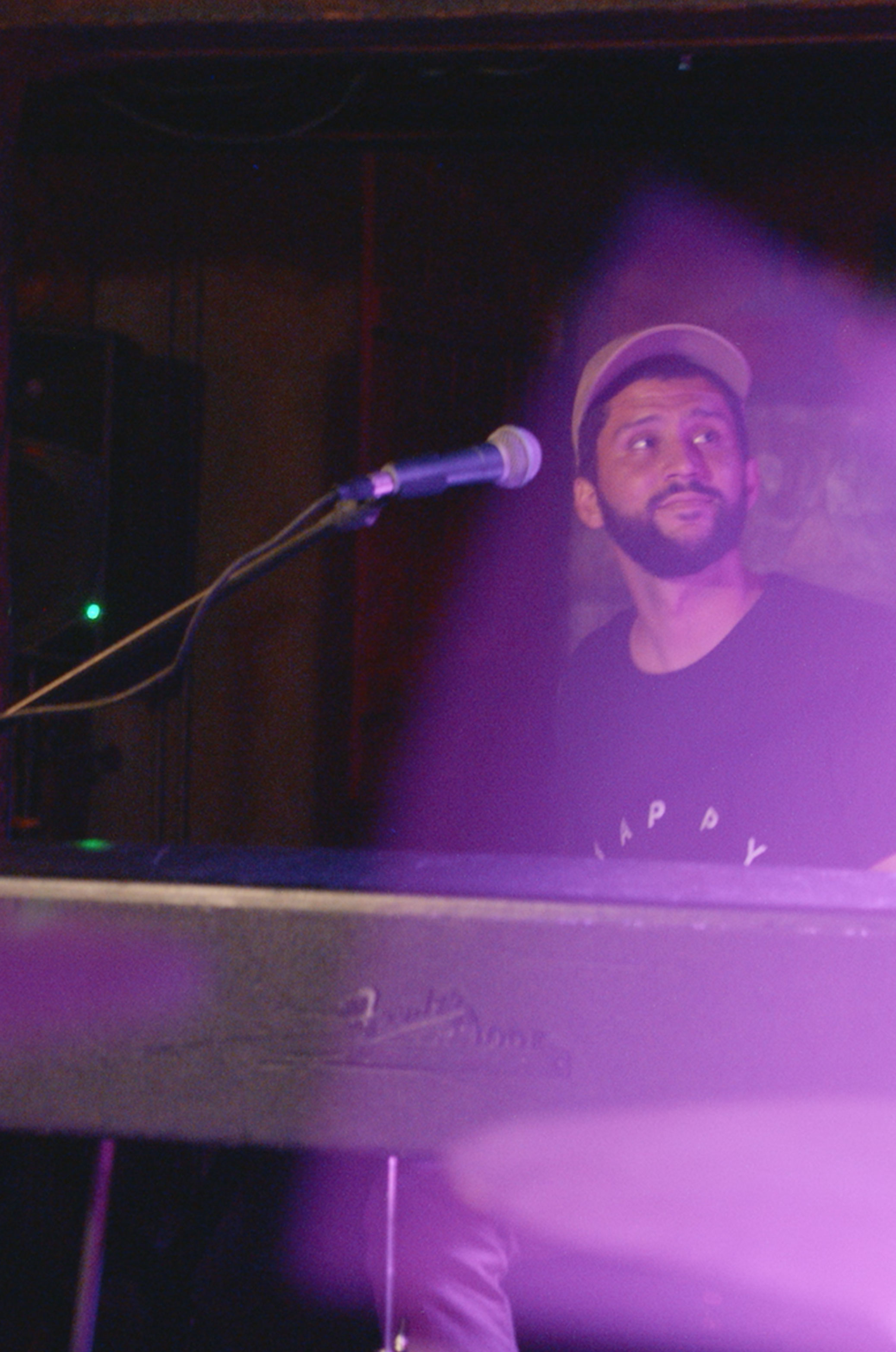How a beat-making jazz pianist reflects what he wants to see in the world.
Peering into the doorway of an apartment on Los Angeles’ Westside, the person l’m looking for is nowhere in sight, but I can hear him. Kiefer Shackelford (or just Kiefer, as he’s professionally known) is half-humming, half-singing to himself from... somewhere within these walls. A few steps further and I find him tidying up the far corner next to the kitchen, shuffling papers in a semi-mad dash to make time. In about 15 minutes, he’s scheduled to give a piano lesson, but by some small blessing his student, a 14-year-old named Nico, texts him to say he’s running late.
Shortly after, Nico arrives and immediately sits down at one of the two pianos lining the living room wall, bisected by a Yamaha keyboard that gives the setup its top-heavy T-shape. He and Kiefer kick off the lesson by migrating to the laptop in the newly cleaned corner, where they listen to jazz covers on Youtube, oscillating between studious silence and vocal enthusiasm as they dissect solos down to the note. After the listening exercise, they sit back down at the keyboard and piano and launch into an improvisation, twenty fingers fluttering across the keys whilst the rich tones combine to fill the modest space. The perpendicularity of their seating arrangement allows them to look over their shoulder to see what the other is doing while playing.
During their session, Nico seems to stumble upon a sequence that catches his teacher’s attention. Kiefer pauses and asks him to play it again, once more looking over his shoulder as Nico attempts to recreate his happy accident. “That was really cool,” he nods, trying it out for himself.
Nico, Kiefer told me earlier, is one of his favorite students. He’s talented and has potential, but more importantly, “he wants to learn and be good.” When the lesson winds down, Kiefer fills an index card with assignments to be completed by their next meeting. Even after their time together has officially ended, they chat for an extra 20 minutes about Nico’s future prospects as a professional jazz musician. Kiefer, while encouraging, doesn’t sugarcoat things: The local scene is extremely competitive, he says, even if you’re talented and hardworking.
“Are you still gigging?” asks Nico. “I just did a gig last night, actually,” Kiefer replies.
To call it just “a gig,” though, is an understatement. Kiefer was headlining a show marking the release of his latest album, Happysad, on the revered Stones Throw Records label. His music, a soothing and soulful fusion of jazz piano and hip-hop-influenced beats, is well at home among labelmates past and present, and prolific and up-and-coming, such as J Dilla, Dâm-Funk, Karriem Riggins, and Sudan Archives. It’s a milestone worth celebrating (and indeed, a small afterparty followed back at the apartment), but the next morning he’s back to teaching piano, which he does twice daily, seven days a week unless he’s touring.
“I don’t have any weekends or weekdays,” he says of his schedule. “That concept is kind of alien to me.” He’s been giving lessons for nearly ten years, beginning when he was in high school; after graduating from college, he taught full-time at a nearby private school, a stable paycheck compared to the gigging grind. These days, Kiefer teaches on his own, and most of his students are closer to his age (27), though he occasionally helps high schoolers prepare for college auditions.
The way he interacts with Nico, patiently and casually, more like a friend than a teacher, makes him seem like someone who can coach a novice well beyond “Mary Had a Little Lamb.” In reality, he’s hesitant to take on beginners. “If someone has never played a note in their life, I’m not really good at that,” he admits afterward. “I tend to teach more conceptually.
“With Nico, I’m just trying to break his mind, break it down a little bit so that he’s not doing the same things all the time and making him realize that jazz is more than high school teachers telling the band to play the notes. It’s like, you can take this phrase and play it upside down and backwards, take it apart and put it back together.”
“I want people to feel good about the lives that they live, because there was a time when I didn’t really feel that positive about my life at all. Then things got better… I think that’s a cool narrative that I can help share.”
Despite his relatively young age, Kiefer’s been around jazz long enough to play with it like a box of Legos. His dad taught him to play piano as a young child (“There are videos of me standing on the piano bench when I was barely old enough to stand,” he told bandcamp) and introduced him to jazz, while his mom taught him to read music. During his teenage years, he began seriously considering it as a career, going on to major in Jazz Studies at the University of California, Los Angeles. (The program, directed by famed guitarist Kenny Burrell, counts rising star Kamasi Washington as one of its most notable students in recent years.)
It was also during his teens that he began to explore beatmaking. What started out as casually making loops out of drums, bass, and piano on the family iMac’s Garageband turned into a daily obsession during his college years. A serendipitous trek in 2013 to Low End Theory, the now-defunct, culture-defining club night at The Airliner in East LA’s Lincoln Heights, sealed the deal when he saw cosmic funk-maker MNDSGN, a Stones Throw affiliate and future collaborator, perform.
“I met him shortly after and after going to his house a bunch and watching him work and listening to music with him and talking with him I was incredibly inspired,” Kiefer recalls. “That was probably about that time that I really started pushing harder because I was really inspired about what he was doing.”
During various moments of downtime throughout the day, Kiefer usually heads straight back to his piano, whether he’s putting on an impromptu concert with his musician roommate and friends or jamming solo. He plinks away in short spurts, the way an illustrator doodles in the margins of their notebook or on a spare napkin, just because.
This stream-of-consciousness approach is integral to Kiefer’s creative process. He begins his tracks by improvising for a few minutes on piano, summoning the feelings and ideas that have been swimming around in his head and expanding on the first one that really sticks with him.
On the surface, his music is a similarly fluid, seemingly effortless listen that curls through the ears like a light breeze on a sunny afternoon. It conjures images of azure skies and finding shapes in marshmallow clouds, lazy Sunday mornings wrapped in a favorite blanket — music to get lost and burrow in. Kiefer says his goal is to find beauty in the world and translate it through his music, but deeper discussion reveals that not all the beauty he finds is as conventionally pretty or comfortable as the pictures it paints.
The closer you listen to Kiefer’s albums, the more some of his songs sound more cold-brewed in melancholy than just simply laid-back. During the making of his 2017 full-length debut, Kickinit Alone, he grappled with depression following a particularly difficult breakup. Rather than try to avoid those emotions, he elected to confront them head-on through his work. “That was my way of negotiating those feelings but also try to go about my daily life and and record music,” he says. One song, “Butterfly Inside My House,” sounds as fleeting and fragile as its namesake; in “Most Beautiful Girl,” the resonant chords feel especially wistful. “Found what you’re looking for?” a voice asks at the end of “IDK.” “Not quite,” another replies. Ultimately, the LP’s closers, “Reinvent Yo Self” and its title track, leave listeners on a brighter note — hope for better days ahead.
A year later, Happysad finds him still looking within, this time examining the bond between ambition and anxiety. The latter can attack the former with the force of a boa constrictor, tightening its grip around the chest and waiting for inevitable submission. For years, Kiefer experienced panic attacks, which developed into periods of panic disorder (in which the mere fear of attacks can end up causing one) and agoraphobia, a fear of places or situations that may induce panic.
In some extreme cases, sufferers avoid leaving the familiarity and safety of their home, which in addition to affecting one’s social life and general wellbeing can pose a particular challenge to musicians who are constantly gigging. The album’s joyful start, including tracks “What A Day,” “Highway 46,” and “Highway 41” (which he described as reflecting the meditative nature of driving through LA on a beautiful day) shrinks into the downcast vibes of “FOMO” and “Agoraphobia,” while the all-caps “AAAAA” captures the loneliness and frustration of being stuck at home while his friends go out without him (again).
“I usually just sit and play and think about my day as if you were to sit down and write in your diary, you know?”
In all of this, Kiefer managed to find a silver lining. What if anxiety could fuel his ambition rather than suffocate it? “Anxiety’s not all bad,” says Kiefer. “I think that’s something really important for someone with anxiety to recognize. It’s there naturally; we’ve evolved to have it for a reason. It gets me off the couch every day to do shit. But I think self-awareness is key and you should be able to evaluate for yourself what is too much. In most cases, it is too much and there’s a way to be aware of things that are troubling you without worrying yourself to death.”
After Nico’s lesson, I finally have a chance to look closely at Kiefer’s piano, though not so much for the instrument itself as what’s on it: A neon rainbow of dog-eared sticky notes slapped across the upper panel. (“There used to be a lot more, but they fell off,” he says.) Each square has a handwritten motivational quote: “Growth Takes Time. A Flower Does Not Bloom Before Your Eyes…” one reads. Another says, “When I go to bed at night, I always ask myself what activity I wish I had done that day. More often than not I wish that I had played more music. Play music everyday that you are alive.”
A quick scroll through Kiefer’s Twitter feed, among his many NBA-related musings, offers similar nuggets of wisdom. All of these notes, scrawled in pen or sent by iPhone, are just as much for him as they are for his students and fans; much-needed reminders of what everyone is capable of with patience, passion, and a lot of hard work. Whether he’s performing onstage, mid-lesson with a student, or uploading batches of instrumentals so his online followers can create their own virtual jam sessions, he lives by a simple mantra passed down to him by one of his mentors: “Be encouraged and encourage others.” Watching him sit down with Nico was proof of that exchange.
As the day wraps up, my final question for Kiefer is what he ultimately wants his legacy to be. “I don’t know if ‘want’ has anything to do with it,” he begins, “but I am trying to do things the right way. I think if I do that, if there is any sort of legacy, hopefully it’ll be positive. Just trying to do things the right way and be encouraging and dedicating myself to the discipline of music itself.”
Kiefer – Finding Beauty (Documentary) is out now exclusively on Majestic Casual. Watch now below.
Written by Krystal Rodriguez
This interview was originally recorded in autumn 2018. Since then, Kiefer has released the critically acclaimed EP Bridges on Stones Throw available to stream now.









